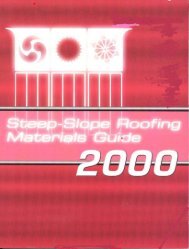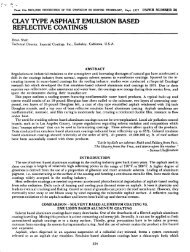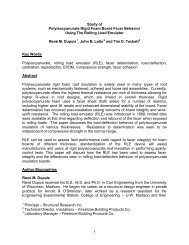2005-2006 steep-slope roofing materials guide - National Roofing ...
2005-2006 steep-slope roofing materials guide - National Roofing ...
2005-2006 steep-slope roofing materials guide - National Roofing ...
Create successful ePaper yourself
Turn your PDF publications into a flip-book with our unique Google optimized e-Paper software.
is a compilation of conditions that appear in roof<br />
warranties submitted to NRCA; the language<br />
appearing in the various conditions is not<br />
necessarily the exact document appearing in a<br />
specific warranty document, but it reflects the<br />
intent.<br />
Index of specific conditions that make a<br />
warranty ineffective or void<br />
A. Shingles are not applied in accordance<br />
with manufacturer’s application<br />
instructions or specifications<br />
B. Deck over which the shingles have been<br />
applied does not meet building code<br />
minimum requirements<br />
C. Roof structure is not properly vented;<br />
roof structure does not have thorough<br />
ventilation meeting building code<br />
minimum requirements; ventilation does<br />
not meet FHA minimum property<br />
standards<br />
D. Absence of underlayment in new<br />
construction or tear-off to deck<br />
E. Repairs or expenditures incurred before<br />
manufacturer’s acknowledgement and<br />
acceptance of claim<br />
F. Shingles that are purchased or installed<br />
outside the United States or Canada<br />
G. Warranty registration form is not<br />
executed and submitted to manufacturer<br />
upon application of shingles<br />
H. Shingles are not installed by a <strong>roofing</strong><br />
contractor certified by the manufacturer<br />
I. Lack of proper notification<br />
14. Inclusion of consequential damages:<br />
The entry no in this category indicates the<br />
warranty does not cover consequential<br />
damages that may result from a roof leak, such<br />
as damage to the interior of the building. The<br />
majority of roof warranties expressly exclude<br />
consequential damages.<br />
15. Assignability: Similar to other legal<br />
documents, warranties can generally be<br />
“assigned” or “transferred” by one party to<br />
another unless there is a specific prohibition<br />
against such assignment. Some <strong>roofing</strong><br />
warranties contain such prohibitions, and some<br />
state specifically no assignment or transfer will<br />
be allowed without the prior written permission<br />
of the manufacturer. The entry No restrictions<br />
stated indicates the warranty contains no<br />
provision barring, limiting or conditioning the<br />
<strong>2005</strong>-<strong>2006</strong> Steep-<strong>slope</strong> <strong>Roofing</strong> Materials Guide 20<br />
owner’s rights to assign the warranty to a<br />
subsequent owner or party.<br />
16. Cost to obtain: This is the amount, if any,<br />
the manufacturer charges for the warranty. The<br />
entry None in this category means there is not a<br />
separate charge, apart from the cost of<br />
purchasing the <strong>materials</strong>, for the warranty.<br />
When there is a separate charge, it will<br />
generally be stated on a per-square (100<br />
square feet) basis.<br />
17. Warranty backed by insurance<br />
coverage: This category indicates whether an<br />
insurance company is listed on the face of the<br />
warranty document and whether the<br />
manufacturer has insurance applicable to its<br />
warranty obligations. The entry No indicates no<br />
insurance company is named on the face of the<br />
warranty document, meaning the owner or<br />
other claimant would not be entitled to assert a<br />
claim against an insurance company in the<br />
event the manufacturer were unable to satisfy<br />
its warranty commitments.<br />
NRCA also asks manufacturers whether they<br />
carry insurance covering their warranty<br />
obligations and, if so, the type and amount of<br />
coverage. The manufacturer’s response is<br />
included as part of the information provided in<br />
this category.<br />
18. Exclusive or additional remedy: Under<br />
general legal principles, unless the warranty<br />
document specifically excludes other warranties<br />
and remedies that may be available to the<br />
owner and the owner agrees to be bound by the<br />
warranty terms, the rights and remedies set<br />
forth in the warranty document are in addition to<br />
those warranties, rights and remedies that may<br />
be available to the owner or other claimant<br />
under state, statutory or common law. In<br />
addition to providing an owner with specific<br />
rights, warranty documents are frequently used<br />
as a liability-limiting device so that the liability of<br />
the party issuing the warranty is limited to what<br />
is prescribed in the warranty document. If the<br />
warranty states that it is an exclusive warranty<br />
and is issued in lieu of all other warranties, the<br />
claimant may not be entitled to seek recovery<br />
from the manufacturer based on the breach of<br />
any other warranties, express or limited.<br />
The manufacturer’s warranty may exclude or<br />
seek to exclude the implied and express<br />
warranties established by the Uniform





